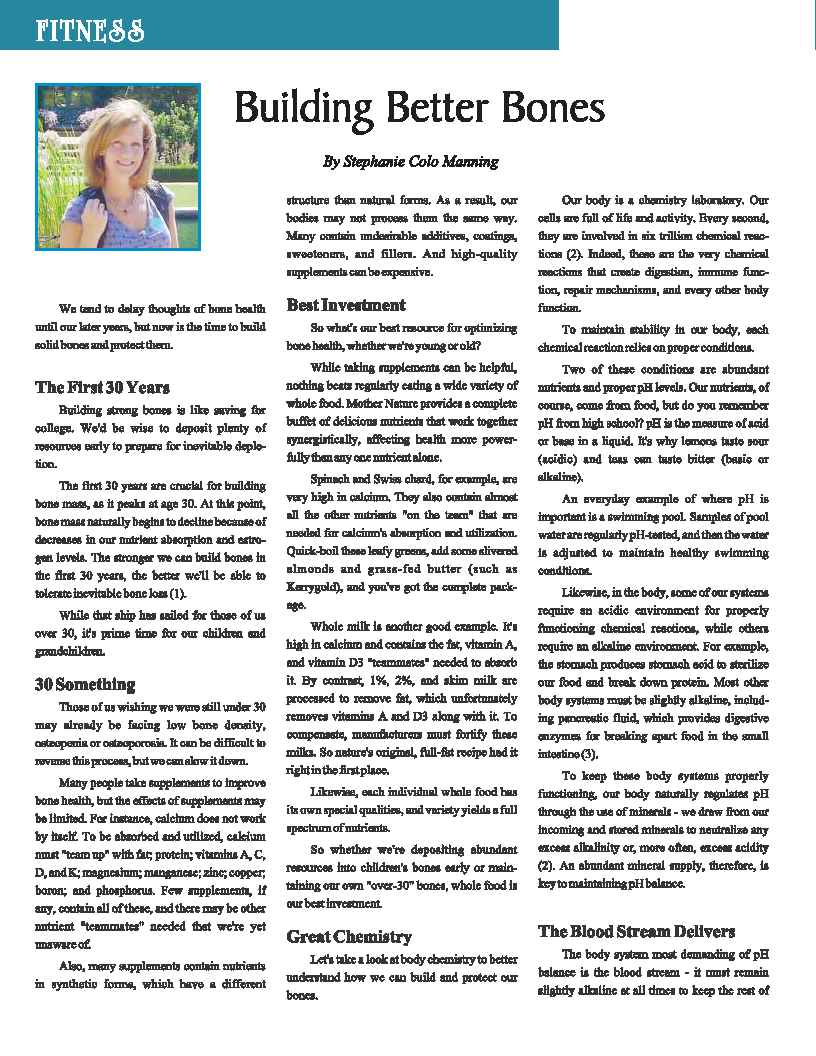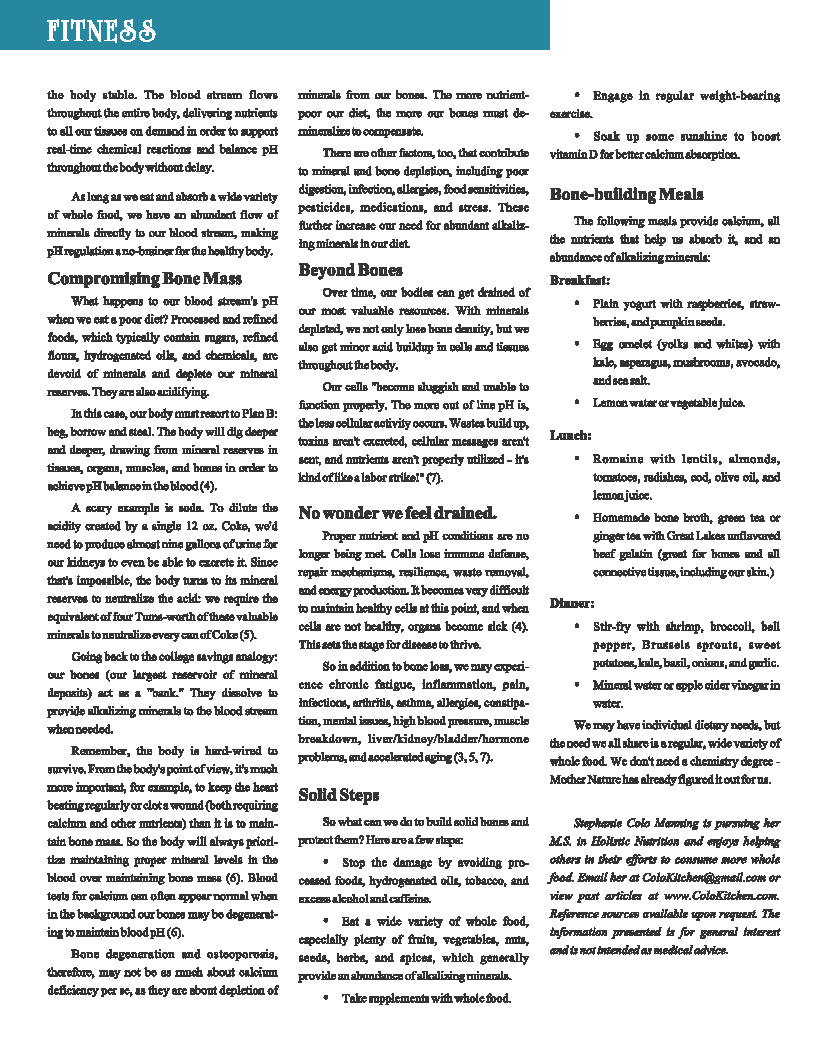By Stephanie Colo Manning
We tend to delay thoughts of bone health until our later years, but now is the time to build solid bones and protect them.
The First 30 Years
Building strong bones is like saving for college. We’d be wise to deposit plenty of resources early to prepare for inevitable depletion.
The first 30 years are crucial for building bone mass, as it peaks at age 30. At this point, bone mass naturally begins to decline because of decreases in our nutrient absorption and estrogen levels. The stronger we can build bones in the first 30 years, the better we’ll be able to tolerate inevitable bone loss (1).
While that ship has sailed for those of us over 30, it’s prime time for our children and grandchildren.
30 Something
Those of us wishing we were still under 30 may already be facing low bone density, osteopenia or osteoporosis. It can be difficult to reverse this process, but we can slow it down.
Many people take supplements to improve bone health, but the effects of supplements may be limited. For instance, calcium does not work by itself. To be absorbed and utilized, calcium must “team up” with fat; protein; vitamins A, C, D, and K; magnesium; manganese; zinc; copper; boron; and phosphorus. Few supplements, if any, contain all of these, and there may be other nutrient “teammates” needed that we’re yet unaware of.
Also, many supplements contain nutrients in synthetic forms, which have a different structure than natural forms. As a result, our bodies may not process them the same way. Many contain undesirable additives, coatings, sweeteners, and fillers. And high-quality supplements can be expensive.
Best Investment
So what’s our best resource for optimizing bone health, whether we’re young or old?
While taking supplements can be helpful, nothing beats regularly eating a wide variety of whole food. Mother Nature provides a complete buffet of delicious nutrients that work together synergistically, affecting health more powerfully than any one nutrient alone.
Spinach and Swiss chard, for example, are very high in calcium. They also contain almost all the other nutrients “on the team” that are needed for calcium’s absorption and utilization. Quick-boil these leafy greens, add some slivered almonds and grass-fed butter (such as Kerrygold), and you’ve got the complete package!
Whole milk is another good example. It’s high in calcium and contains the fat, vitamin A, and vitamin D3 “teammates” needed to absorb it. By contrast, 1%, 2%, and skim milk are processed to remove fat, which unfortunately removes vitamins A and D3 along with it. To compensate, manufacturers must fortify these milks. So nature’s original, full-fat recipe had it right in the first place.
Likewise, each individual whole food has its own special qualities, and variety yields a full spectrum of nutrients.
So whether we’re depositing abundant resources into children’s bones early or maintaining our own “over-30” bones, whole food is our best investment.
Great Chemistry
Let’s take a look at body chemistry to better understand how we can build and protect our bones.
Our body is a chemistry laboratory. Our cells are full of life and activity. Every second, they are involved in six trillion chemical reactions (2). Indeed, these are the very chemical reactions that create digestion, immune function, repair mechanisms, and every other body function.
To maintain stability in our body, each chemical reaction relies on proper conditions.
Two of these conditions are abundant nutrients and proper pH levels. Our nutrients, of course, come from food, but do you remember pH from high school? pH is the measure of acid or base in a liquid. It’s why lemons taste sour (acidic) and teas can taste bitter (basic or alkaline).
An everyday example of where pH is important is a swimming pool. Samples of pool water are regularly pH-tested, and then the water is adjusted to maintain healthy swimming conditions.
Likewise, in the body, some of our systems require an acidic environment for properly functioning chemical reactions, while others require an alkaline environment. For example, the stomach produces stomach acid to sterilize our food and break down protein. Most other body systems must be slightly alkaline, including pancreatic fluid, which provides digestive enzymes for breaking apart food in the small intestine (3).
To keep these body systems properly functioning, our body naturally regulates pH through the use of minerals – we draw from our incoming and stored minerals to neutralize any excess alkalinity or, more often, excess acidity (2). An abundant mineral supply, therefore, is key to maintaining pH balance.
The Blood Stream Delivers
The body system most demanding of pH balance is the blood stream – it must remain slightly alkaline at all times to keep the rest of the body stable. The blood stream flows throughout the entire body, delivering nutrients to all our tissues on demand in order to support real-time chemical reactions and balance pH throughout the body without delay.
As long as we eat and absorb a wide variety of whole food, we have an abundant flow of minerals directly to our blood stream, making pH regulation a no-brainer for the healthy body.
Compromising Bone Mass
What happens to our blood stream’s pH when we eat a poor diet? Processed and refined foods, which typically contain sugars, refined flours, hydrogenated oils, and chemicals, are devoid of minerals and deplete our mineral reserves. They are also acidifying.
In this case, our body must resort to Plan B: beg, borrow and steal. The body will dig deeper and deeper, drawing from mineral reserves in tissues, organs, muscles, and bones in order to achieve pH balance in the blood (4).
A scary example is soda. To dilute the acidity created by a single 12 oz. Coke, we’d need to produce almost nine gallons of urine for our kidneys to even be able to excrete it. Since that’s impossible, the body turns to its mineral reserves to neutralize the acid: we require the equivalent of four Tums-worth of these valuable minerals to neutralize every can of Coke (5).
Going back to the college savings analogy: our bones (our largest reservoir of mineral deposits) act as a “bank.” They dissolve to provide alkalizing minerals to the blood stream when needed.
Remember, the body is hard-wired to survive. From the body’s point of view, it’s much more important, for example, to keep the heart beating regularly or clot a wound (both requiring calcium and other nutrients) than it is to maintain bone mass. So the body will always prioritize maintaining proper mineral levels in the blood over maintaining bone mass (6). Blood tests for calcium can often appear normal when in the background our bones may be degenerating to maintain blood pH (6).
Bone degeneration and osteoporosis, therefore, may not be as much about calcium deficiency per se, as they are about depletion of minerals from our bones. The more nutrient-poor our diet, the more our bones must de-mineralize to compensate.
There are other factors, too, that contribute to mineral and bone depletion, including poor digestion, infection, allergies, food sensitivities, pesticides, medications, and stress. These further increase our need for abundant alkalizing minerals in our diet.
Beyond Bones
Over time, our bodies can get drained of our most valuable resources. With minerals depleted, we not only lose bone density, but we also get minor acid buildup in cells and tissues throughout the body.
Our cells “become sluggish and unable to function properly. The more out of line pH is, the less cellular activity occurs. Wastes build up, toxins aren’t excreted, cellular messages aren’t sent, and nutrients aren’t properly utilized – it’s kind of like a labor strike!” (7).
No wonder we feel drained.
Proper nutrient and pH conditions are no longer being met. Cells lose immune defense, repair mechanisms, resilience, waste removal, and energy production. It becomes very difficult to maintain healthy cells at this point, and when cells are not healthy, organs become sick (4). This sets the stage for disease to thrive.
So in addition to bone loss, we may experience chronic fatigue, inflammation, pain, infections, arthritis, asthma, allergies, constipation, mental issues, high blood pressure, muscle breakdown, liver/kidney/bladder/hormone problems, and accelerated aging (3, 5, 7).
Solid Steps
So what can we do to build solid bones and protect them? Here are a few steps:
- Stop the damage by avoiding processed foods, hydrogenated oils, tobacco, and excess alcohol and caffeine.
- Eat a wide variety of whole food, especially plenty of fruits, vegetables, nuts, seeds, herbs, and spices, which generally provide an abundance of alkalizing minerals.
- Take supplements with whole food.
- Engage in regular weight-bearing exercise.
- Soak up some sunshine to boost vitamin D for better calcium absorption.
Bone-building Meals
The following meals provide calcium, all the nutrients that help us absorb it, and an abundance of alkalizing minerals:
Breakfast:
- Plain yogurt with raspberries, strawberries, and pumpkin seeds.
- Egg omelet (yolks and whites) with kale, asparagus, mushrooms, avocado, and sea salt.
- Lemon water or vegetable juice.
Lunch:
- Romaine with lentils, almonds, tomatoes, radishes, cod, olive oil, and lemon juice.
- Homemade bone broth, green tea or ginger tea with Great Lakes unflavored beef gelatin (great for bones and all connective tissue, including our skin.)
Dinner:
- Stir-fry with shrimp, broccoli, bell pepper, Brussels sprouts, sweet potatoes, kale, basil, onions, and garlic.
- Mineral water or apple cider vinegar in water.
We may have individual dietary needs, but the need we all share is a regular, wide variety of whole food. We don’t need a chemistry degree – Mother Nature has already figured it out for us.
Stephanie Colo Manning holds a Master of Science degree in Holistic Nutrition. The information presented has not been evaluated by the FDA and is not intended to diagnose, treat, prevent, or cure any disease. References available upon request.


